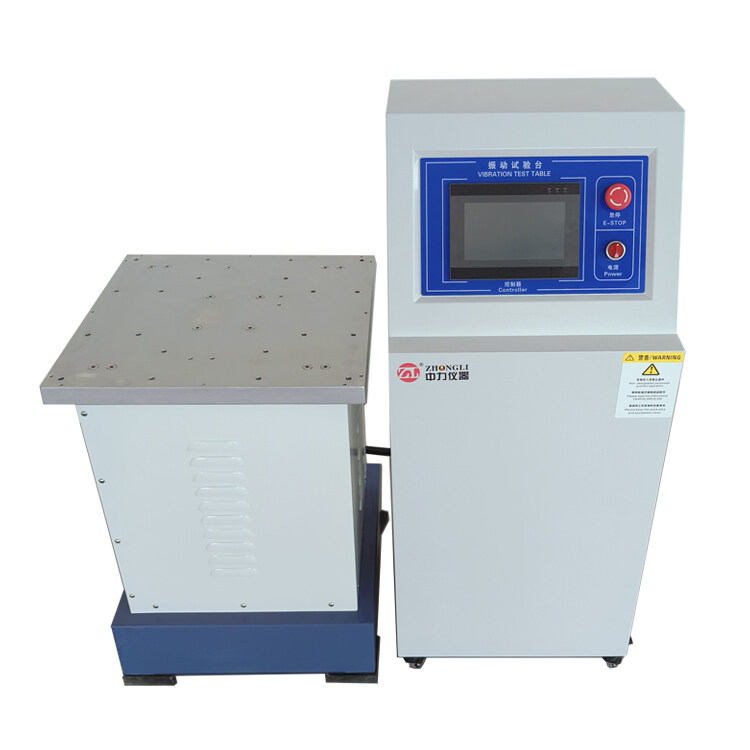The electromagnetic vibration table is an economical, highly cost-effective sinusoidal vibration test equipment (with functions covering fixed frequency vibration, linear frequency sweep vibration, logarithmic frequency sweep, frequency doubling, program, etc.). It simulates the vibration and its impact suffered by electrical and electronic products during transportation (vibration generated on ships, aircraft, vehicles, and spacecraft), storage, and use in the laboratory, and evaluates their adaptability.
1.Product Introduction:
The electromagnetic vibration table is an economical, highly cost-effective sinusoidal vibration test equipment (with functions covering fixed frequency vibration, linear frequency sweep vibration, logarithmic frequency sweep, frequency doubling, program, etc.). It simulates the vibration and its impact suffered by electrical and electronic products during transportation (vibration generated on ships, aircraft, vehicles, and spacecraft), storage, and use in the laboratory, and evaluates their adaptability.
The electromagnetic vibration table is widely used in the product design, research and development, and manufacturing process of various industries such as automotive parts, instruments, and toys. It simulates the collision and vibration generated by products during transportation and use, and detects the actual working conditions and structural strength of the products.
2.Reference Standards:
ISO 2247, ISO 13355, IEC 60068, ASTM D999, ASTM D4728, ASTM D3580, GB/T 4857, GB/T 2423…
3. Product Features:
3.1 The same table realizes X, Y, and Z three-axis vibration, program control, precise frequency, and no drift during long-term operation;
3.2 Stepless adjustment of amplitude, with sweep frequency and fixed frequency functions, to meet the testing requirements of different industries;
3.3 Embedded amplitude prediction program, four-point synchronous excitation, and uniform table vibration;
3.4 Add anti-interference circuit to solve the interference of strong electromagnetic field to the control circuit, and the table is free of magnetism and static electricity.
3.5 Made of composite industrial materials, precision machining, beautiful table body, humanized operation and control, using special measurement and control modules to make the equipment work more stable.
4.Technical Parameters:
|
Product Model |
ZL-1002 |
|
|
Frequency Range (Hz) |
1~600 |
|
|
Product Load (Kg) |
50 (other specifications can be customized) |
|
|
Vibration Direction |
Vertical / vertical horizontal / three-axis (X+Y+Z) optional |
|
|
Workbench Size (mm) |
(W) 500×(D) 500 (other specifications can be customized) |
|
|
Workbench Body size (mm) |
(W) 500×(D) 500×(H) 720 |
|
|
Control Box Size (mm) |
(W) 450×(D) 400×(H) 1080 |
|
|
Frequency Accuracy |
0.1 Hz |
|
|
Maximum Peak Acceleration |
20g (varies with frequency, cannot be displayed, optional sensor monitoring) |
|
|
Control Method |
7-inch industrial touch screen |
|
|
Amplitude (mm) |
0-5 (varies with frequency, cannot be displayed, optional sensor monitoring) |
|
|
Excitation Method |
Electromagnetic type |
|
|
Amplitude Modulation Method |
Electronic amplitude modulation |
|
|
Vibration Waveform |
Sine wave |
|
|
Time Setting Range |
0-9999H/M/S can be set arbitrarily |
|
|
Number of Cycles |
0-9999 can be set arbitrarily |
|
|
Safety Protection |
Over temperature, phase loss, short circuit, over current, overload |
|
|
Cooling Method |
Air cooling |
|
|
T E S T
M O D E
|
Fixed frequency test: A sinusoidal vibration test is performed at a selected frequency (which can be a resonant frequency, a specific frequency, or a dangerous frequency) at a specified value and for a specified period of time. |
|
|
Sweep frequency test: Within the specified frequency range, the frequency is swept from low frequency to high frequency and then from high frequency to low frequency at a certain scanning rate according to the specified value until the specified total number or time is reached. |
||
|
Frequency octave test: The frequency sweep should be continuous and its frequency should change exponentially with time. The sweep rate (the rate of change of the controllable variable frequency over time during the sweep process df/dt) should be one octave per minute. The test time (acceleration time) for the frequency range to sweep from f1→f2→f1 once is calculated by the formula: 6.644log10 (high frequency/low frequency), and the sweep rate meets the requirement of 1 octave/minute. |
||
|
Logarithmic test: In logarithmic mode, the low frequency scanning speed is slow, and the high frequency scanning speed is fast. The logarithmic sweep is in units of 1 minute, and the sweep rate is doubled in 1 minute. |
||
|
Random test: Random vibration is a non-deterministic vibration. When an object vibrates randomly, we cannot determine in advance the instantaneous value of the motion parameter of a certain monitoring point on the object at a certain moment in the future. |
||
|
Program test: According to the test requirements, different test frequencies and times can be set, and single or multiple groups can be used. |
||
|
Power Supply Voltage (V/Hz) |
220/50±5% |
|
|
Power Consumption (KVA) |
1.5 |
|
|
Total Machine weight (Kg) |
245 |
|
© Dongguan Zhongli Instrument Technology Co., Ltd.
Leave your inquiry, we will provide you with quality products and services!
Please fill out the form below to request a quote or to request more information about us. please be as detailed as possible in your message, and we will get back to you as soon as possible with a response. we’re ready to start working on your new project, contact us now to get started.
